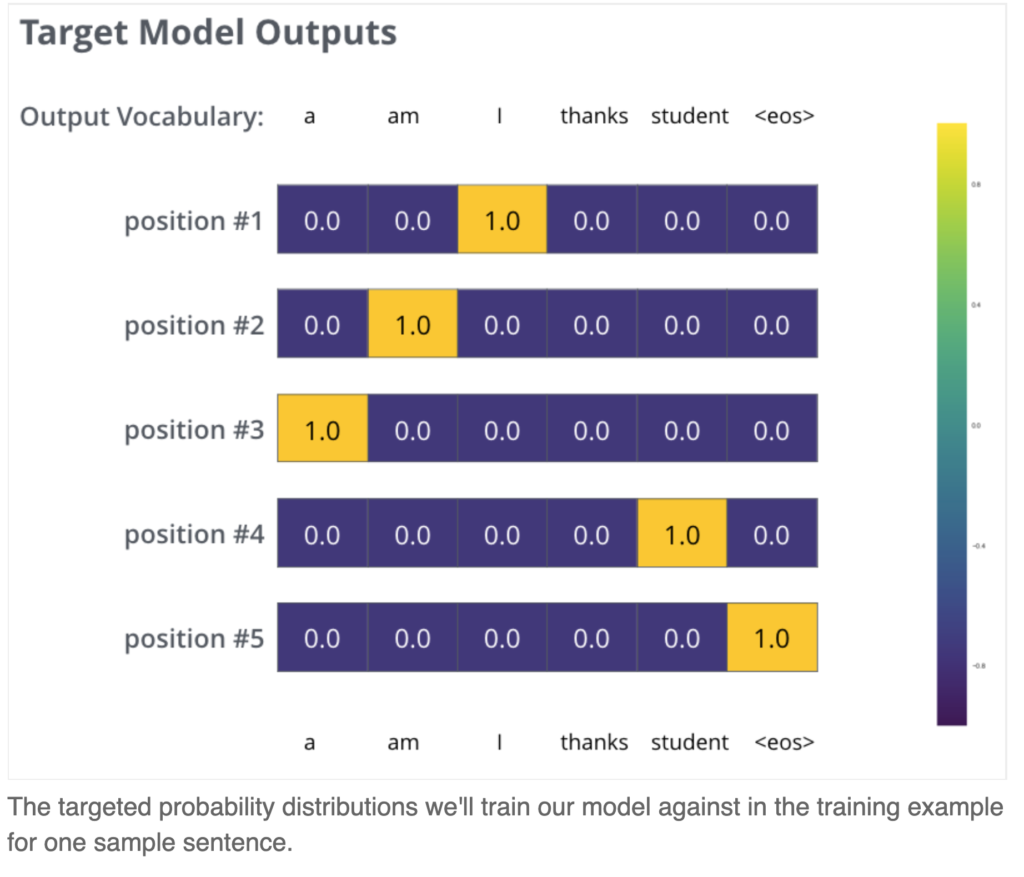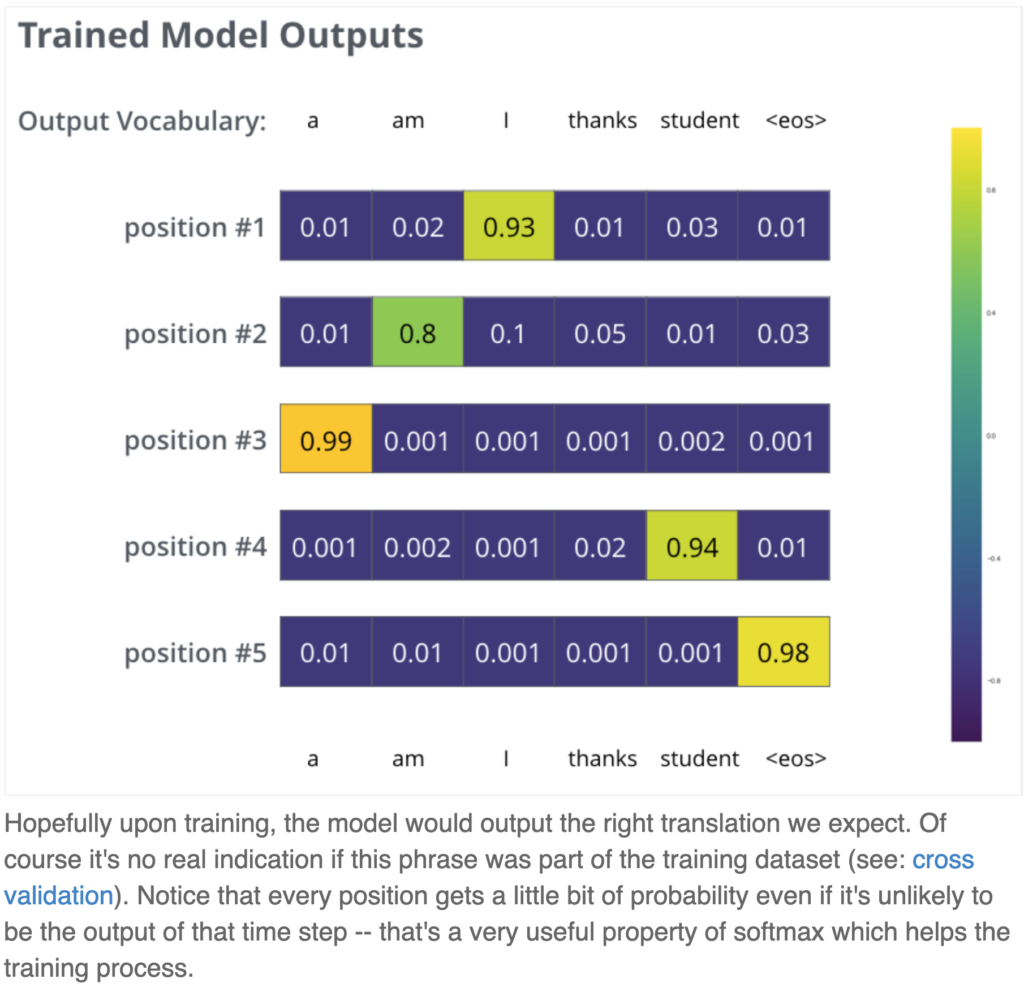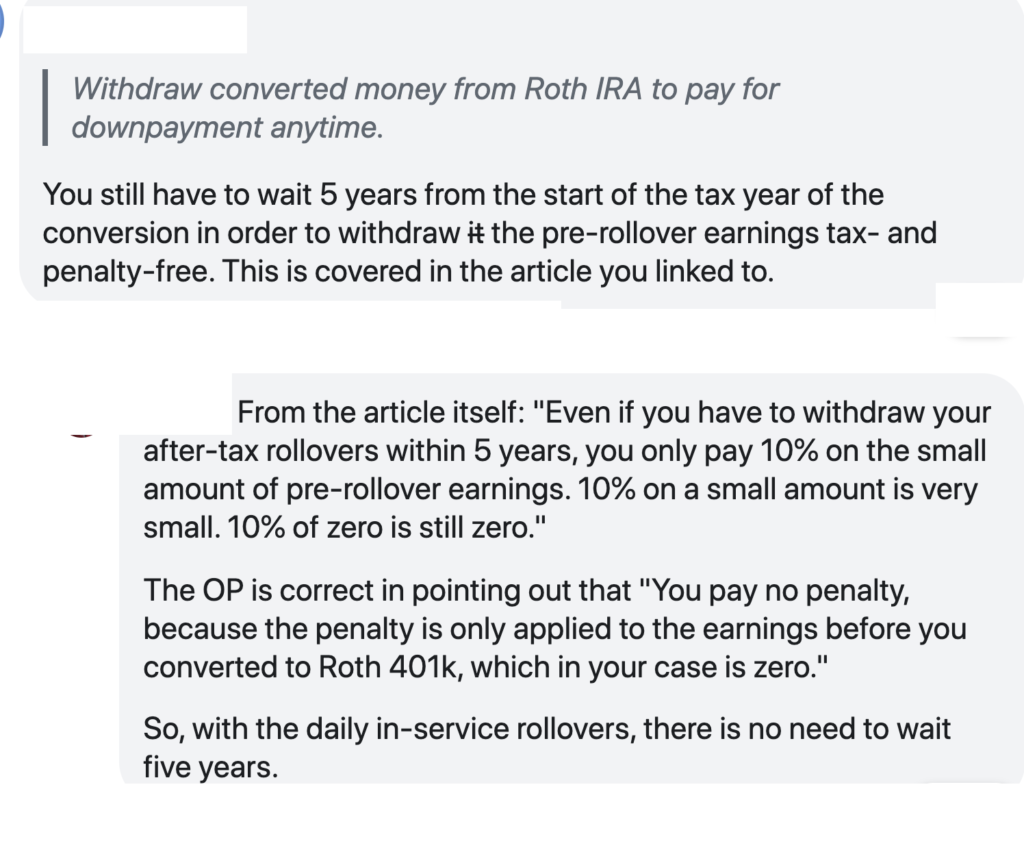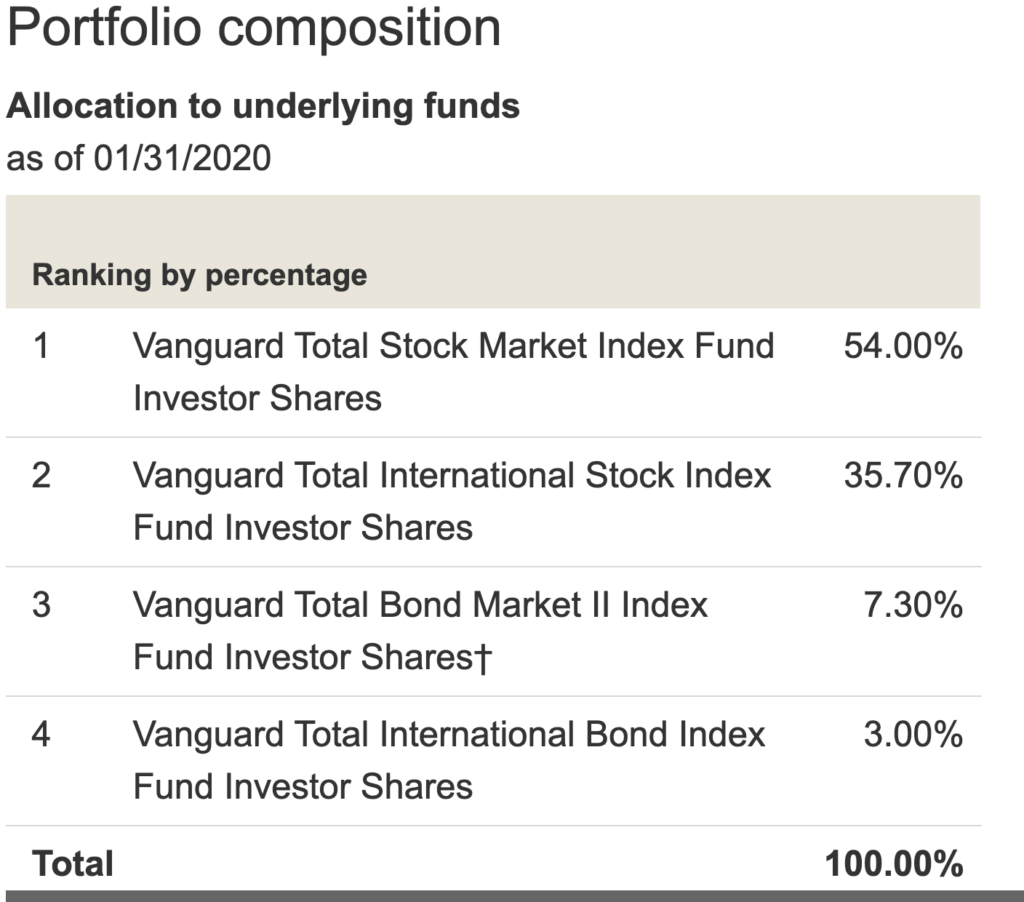Evaluating trained RL policies offline is extremely important in real-world production: a trained policy with unexpected behaviors or unsuccessful learning would cause the system regress online therefore what safe to do is to evaluate their performance on the offline training data, based on which we decide whether to deploy. Evaluating policies offline is an ongoing research topic called “counterfactual policy evaluation” (CPE): what would a policy perform even though we only have trajectories that were generated by some other policy?
CPE for contextual bandit
We first look at CPE on contextual bandit problems. The contextual bandit problem is to take action  at each state
at each state  that is drawn from a distribution
that is drawn from a distribution  . We can only observe the reward associated to that specific pair of
. We can only observe the reward associated to that specific pair of  and
and  :
:  . Rewards associated to other actions not taken
. Rewards associated to other actions not taken  can’t be observed. The next state at which you would take the next action, will not be affected by the current state or action. Essentially, contextual bandit problems are Markov Decision Problems when horizon (the number of steps) equals one. Suppose we have a dataset
can’t be observed. The next state at which you would take the next action, will not be affected by the current state or action. Essentially, contextual bandit problems are Markov Decision Problems when horizon (the number of steps) equals one. Suppose we have a dataset  with
with  samples, each sample being a tuple
samples, each sample being a tuple  .
.  is sampled from a behavior policy
is sampled from a behavior policy  .
.  is calculated based on an underlying but non-observable reward function
is calculated based on an underlying but non-observable reward function  . For now, we ignore any noise that could exist in reward collection. To simplify our calculation, we will assume that the decision of
. For now, we ignore any noise that could exist in reward collection. To simplify our calculation, we will assume that the decision of  is independent across samples: this assumption bypasses the possible fact that
is independent across samples: this assumption bypasses the possible fact that  may maintain an internal memory
may maintain an internal memory  , which is the history of observations used to facilitate its future decisions. We will also assume that during data collection we can access the true probability
, which is the history of observations used to facilitate its future decisions. We will also assume that during data collection we can access the true probability  , the true action propensity of the behavior policy. This is not difficult to achieve in practice because we usually have the direct access to the current policy’s model. We will call the policy that we want to evaluate target policy, denoted as
, the true action propensity of the behavior policy. This is not difficult to achieve in practice because we usually have the direct access to the current policy’s model. We will call the policy that we want to evaluate target policy, denoted as  .
.
Given all these notations defined, the value function of  is:
is:
![Rendered by QuickLaTeX.com V^{\pi_1} = \mathbb{E}_{s \sim \mathcal{D}, a \sim \pi_1(\cdot|s)}[r(s,a)]](https://czxttkl.com/wp-content/ql-cache/quicklatex.com-f4a1d1e00e97065f04cbd2ce40b97fbf_l3.png)
A straightforward way called Direct Method (DM) to estimate  is to train an approximated reward function
is to train an approximated reward function  and plug into
and plug into  :
:

There is one condition to be satisfied for the proof to be hold: if  then
then  . First, we don’t need to worry about that any
. First, we don’t need to worry about that any  exists in the denominator of
exists in the denominator of  because those samples would never be collected in
because those samples would never be collected in  in the first place. However, if
in the first place. However, if  for some
for some  , there would never be data to evaluate the outcome of taking action
, there would never be data to evaluate the outcome of taking action  at state
at state  , which means
, which means  becomes a biased estimator of
becomes a biased estimator of  . (Part of these ideas comes from [7].)
. (Part of these ideas comes from [7].)
The intuition behind  is that:
is that:
- If
 is a large (good) reward, and if
is a large (good) reward, and if  , then we guess that
, then we guess that  is probably better than
is probably better than  because
because  may give actions leading to good rewards larger probabilities than
may give actions leading to good rewards larger probabilities than  .
.
- If
 is a small (bad) reward, and if
is a small (bad) reward, and if  , then we guess that
, then we guess that  is probably worse than
is probably worse than  because
because  may give actions leading to bad rewards larger probabilities than
may give actions leading to bad rewards larger probabilities than  .
.
- We can reverse the relationship such that if
 , we can guess
, we can guess  is better than
is better than  if
if  itself is a bad reward.
itself is a bad reward.  probably is a better policy trying to avoid actions leading to bad rewards.
probably is a better policy trying to avoid actions leading to bad rewards.
- If
 and
and  is a good reward,
is a good reward,  is probably a better policy trying to take actions leading to good rewards.
is probably a better policy trying to take actions leading to good rewards.
We can also relate the intuition of  to Inverse Probability of Treatment Weighting (IPTW) in observational studies [5]. In observational studies, researchers want to determine the effect of certain treatment while the treatment and control selection of subjects is not totally randomized. IPTW is one kind of adjustment to observational data for measuring the treatment effect correctly. One intuitive explanation of IPTW is to weight the subject with how much information the subject could reveal [2]. For example, if a subject who has a low probability to receive treatment and has a high probability to stay in the control group happened to receive treatment, his treatment result should be very informative because he represents the characteristics mostly associated with the control group. In a similar way, we can consider the importance sampling ratio
to Inverse Probability of Treatment Weighting (IPTW) in observational studies [5]. In observational studies, researchers want to determine the effect of certain treatment while the treatment and control selection of subjects is not totally randomized. IPTW is one kind of adjustment to observational data for measuring the treatment effect correctly. One intuitive explanation of IPTW is to weight the subject with how much information the subject could reveal [2]. For example, if a subject who has a low probability to receive treatment and has a high probability to stay in the control group happened to receive treatment, his treatment result should be very informative because he represents the characteristics mostly associated with the control group. In a similar way, we can consider the importance sampling ratio  for each
for each  as an indicator of how much information that sample reveals. When the behavior policy
as an indicator of how much information that sample reveals. When the behavior policy  neglects some action
neglects some action  that is instead emphasized by
that is instead emphasized by  (i.e.,
(i.e.,  ), the sample
), the sample  has some valuable counter-factual information hence we need to “amplify”
has some valuable counter-factual information hence we need to “amplify”  .
.
The third method to estimate  called Doubly Robust (DR) [1] combines the direct method and IPS method:
called Doubly Robust (DR) [1] combines the direct method and IPS method:
![Rendered by QuickLaTeX.com V^{\pi_1}_{DR}=\frac{1}{N}\sum\limits_{(s_i, a_i, r_i) \in \mathcal{S}} \big[\frac{(r_i - \hat{r}(s_i, a_i))\pi_1(a_i|s_i)}{\pi_0(a_i|s_i)} +\int\hat{r}(s_i, a')\pi_1(a'|s_i) da'\big]](https://czxttkl.com/wp-content/ql-cache/quicklatex.com-16c1ae79a43158ca6705a023d35b2d8e_l3.png)
Given our assumption that we know the true action propensity  ,
,  is still an unbiased estimator:
is still an unbiased estimator:
![Rendered by QuickLaTeX.com \mathbb{E}_{p_{\pi_0}(\mathcal{S})}[V^{\pi_1}_{DR}] \newline=\int p_{\pi_0}(s, a) \cdot \big[\frac{(r(s,a) - \hat{r}(s, a))\pi_1(a|s)}{\pi_0(a|s)} +\int \hat{r}(s, a')\pi_1(a'|s) da' \big]ds da \newline=\int p_{\pi_0}(s,a) \cdot\big[\frac{(r(s,a) - \hat{r}(s, a))\pi_1(a|s)}{\pi_0(a|s)} +\int(\hat{r}(s, a') - r(s,a'))\pi_1(a'|s)da' +\int r(s, a')\pi_1(a'|s)da' \big] dsda\newline=\int p_{\pi_1}(s,a) \cdot (-1+1)dsda + \int p_{\pi_1}(s,a) r(s,a) dsda\newline=V^{\pi_1}](https://czxttkl.com/wp-content/ql-cache/quicklatex.com-5b2eddcbd24d5f73844ceadc1403863d_l3.png)
However, in the original paper of DR [1], the authors don’t assume that the true action propensity can be accurately obtained. This means,  can be a biased estimator: however, if
can be a biased estimator: however, if  or
or  have biases under certain bounds,
have biases under certain bounds,  would have far lower bias than either of the other two.
would have far lower bias than either of the other two.
Under the same assumption that the true action propensity is accessible, we could get the variances of DM, DR, and IPS CPE (![Rendered by QuickLaTeX.com Var[V^{\pi_1}_{DM}]](https://czxttkl.com/wp-content/ql-cache/quicklatex.com-12aee5da684ae437aa1a26c635fd139b_l3.png) ,
, ![Rendered by QuickLaTeX.com Var[V^{\pi_1}_{DR}]](https://czxttkl.com/wp-content/ql-cache/quicklatex.com-8e13f1d57c52b4dffceb24ccea350b4d_l3.png) , and
, and ![Rendered by QuickLaTeX.com Var[V^{\pi_1}_{IPS}]](https://czxttkl.com/wp-content/ql-cache/quicklatex.com-b5322ee77892dbe58ae427c62ac99361_l3.png) ) based on the formulas given in Theorem 2 in [1] while setting
) based on the formulas given in Theorem 2 in [1] while setting  because we assume we know the true action propensity:
because we assume we know the true action propensity:



Under some reasonable assumptions according to [1], ![Rendered by QuickLaTeX.com Var[V^{\pi_1}_{DR}]](https://czxttkl.com/wp-content/ql-cache/quicklatex.com-8e13f1d57c52b4dffceb24ccea350b4d_l3.png) should be between
should be between ![Rendered by QuickLaTeX.com Var[V^{\pi_1}_{DM}]](https://czxttkl.com/wp-content/ql-cache/quicklatex.com-12aee5da684ae437aa1a26c635fd139b_l3.png) and
and ![Rendered by QuickLaTeX.com Var[V^{\pi_1}_{IPS}]](https://czxttkl.com/wp-content/ql-cache/quicklatex.com-b5322ee77892dbe58ae427c62ac99361_l3.png) . Therefore,
. Therefore,  should be overall favored because of its zero bias and intermediate variance.
should be overall favored because of its zero bias and intermediate variance.
CPE for MDP
We have completed introducing several CPE methods on contextual bandit problems. Now, we move our focus to CPE on Markov Decision Problems when horizon is larger than 1. The value function of a policy is:
![Rendered by QuickLaTeX.com V^{\pi} = \mathbb{E}_{s_0 \sim \mathcal{D}, a_t \sim \pi(\cdot|s_t), s_{t+1}\sim P(\cdot|a_t, s_t)}[\sum\limits_{t=1}^H\gamma^{t-1}r_t],](https://czxttkl.com/wp-content/ql-cache/quicklatex.com-bfc55bc4eff25229d7795708eb741006_l3.png)
where  is the number of steps in one trajectory. Simplifying the notation of this formula, we get:
is the number of steps in one trajectory. Simplifying the notation of this formula, we get:
![Rendered by QuickLaTeX.com V^{\pi} = \mathbb{E}_{\tau \sim (\pi, \mu)}[R(\tau)],](https://czxttkl.com/wp-content/ql-cache/quicklatex.com-e5c9a9a941f327d049ea0a128cc6e56f_l3.png)
where  is a single trajectory,
is a single trajectory,  denotes the transition dynamics,
denotes the transition dynamics,  is the accumulative discounted rewards for the trajectory
is the accumulative discounted rewards for the trajectory  .
.
Following the idea of IPS, we can have importance-sampling based CPE of  based on trajectories generated by
based on trajectories generated by  :
:

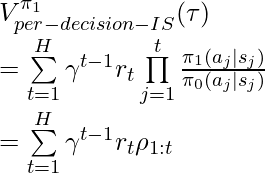
 is an unbiased estimator of
is an unbiased estimator of  given the same condition satisfied in
given the same condition satisfied in  : if
: if  then
then  .
.  is also an unbiased estimator of
is also an unbiased estimator of  proved in [6]. However,
proved in [6]. However,  has lower upper bound than
has lower upper bound than  therefore in practice
therefore in practice  usually enjoys lower variance than
usually enjoys lower variance than  (compare chapter 3.5 and 3.6 in [9]).
(compare chapter 3.5 and 3.6 in [9]).
Following the idea of DR, [3] proposed unbiased DR-based CPE on finite horizons, and later [8] extended to the infinite-horizon case:

where  and
and  are the learned q-value and value function under the behavior policy
are the learned q-value and value function under the behavior policy  .
.  and we define the corner case
and we define the corner case  .
.
Based on Theorem 1 in [3], ![Rendered by QuickLaTeX.com Var[V^{\pi_1}_{DR}]](https://czxttkl.com/wp-content/ql-cache/quicklatex.com-8e13f1d57c52b4dffceb24ccea350b4d_l3.png) should have lower variance than
should have lower variance than ![Rendered by QuickLaTeX.com Var[V^{\pi_1}_{per-decision-IS}]](https://czxttkl.com/wp-content/ql-cache/quicklatex.com-b0bf550ee2c92e20f6b532ef1f593f34_l3.png) , after realizing that per-decision-IS CPE is a special case of DR CPE.
, after realizing that per-decision-IS CPE is a special case of DR CPE.
Another CPE method also proposed by [6] is called Weighted Doubly Robust (WDR). It normalizes  in
in  :
:

where  .
.
 is a biased estimator but since it truncates the range of
is a biased estimator but since it truncates the range of  in
in  to
to ![Rendered by QuickLaTeX.com [0,1]](https://czxttkl.com/wp-content/ql-cache/quicklatex.com-3c2f548a134dfa658b30df58bb768060_l3.png) , WDR could lower variance than DR when fewer samples are available. The low variance of WDR produces larger reduction in expected square error than the additional error incurred by the bias. (See chapter 3.8 of [9]). Furthermore, under reasonable assumptions WDR is a consistent estimator so the bias will become less an issue as the sample size increase. (As a side note, an estimator can be any combination of biased/unbiased and inconsistent/consistent [10].)
, WDR could lower variance than DR when fewer samples are available. The low variance of WDR produces larger reduction in expected square error than the additional error incurred by the bias. (See chapter 3.8 of [9]). Furthermore, under reasonable assumptions WDR is a consistent estimator so the bias will become less an issue as the sample size increase. (As a side note, an estimator can be any combination of biased/unbiased and inconsistent/consistent [10].)
Direct Method CPE on trajectories learns to reconstruct the MDP. This means DM needs to learn the transition function and reward function for simulating episodes.The biggest concern is whether the collected samples support to train a low bias model. If they do, then DM can actually achieve very good performance. [8] Section 6 lists a situation when DM can outperform DR and WDR: while DM has a low variance and low bias (even no bias), stochasticity of reward and state transition produces high variance in DR and WDR.
The last CPE method is called Model and Guided Importance Sampling Combining (MAGIC) [8]. It is considered as the best CPE method because it adopts the advantages from both WDR and DM. The motivation given by [8] is that CPE methods involving importance sampling are generally consistent (i.e., when samples increase, the estimated distribution moves close to the true value) but still suffer high variance; model-based methods (DM) has low variance but is biased. MAGIC combines the ideas of DM and WDR such that MAGIC can track the performance of whichever is better between DM and WDR. The MAGIC method is heavily math involved. Without deep dive into it yet, we only show its pseudocode for now:
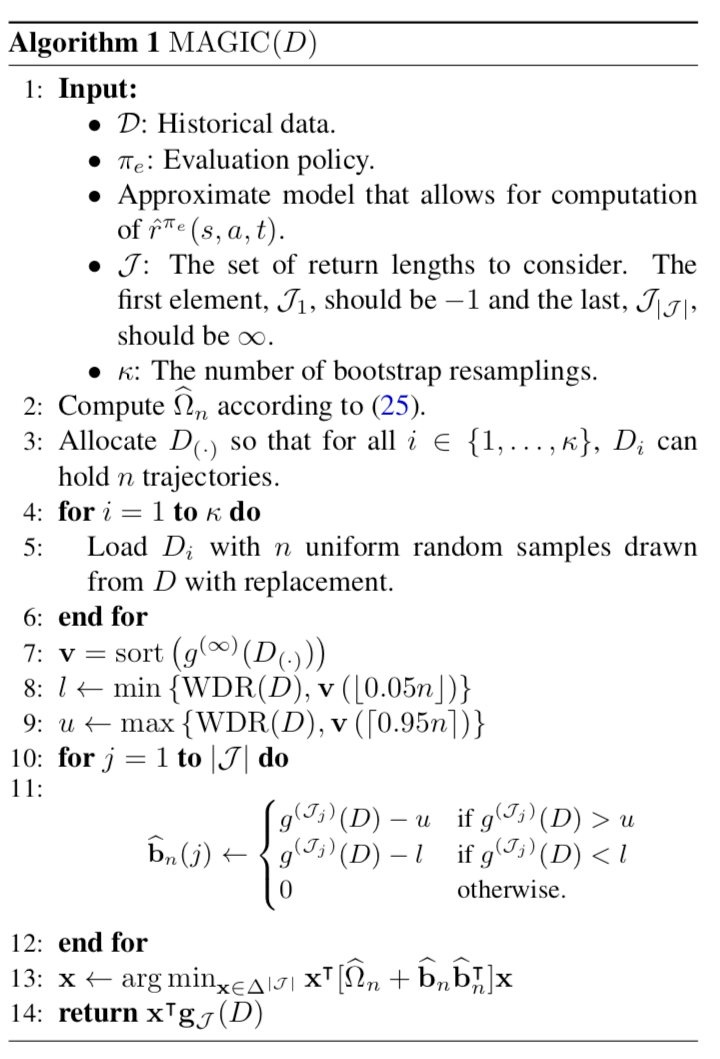
Below is a table concluding this post, showing whether each CPE method (for evaluating trajectories) is biased/unbiased and consistent/inconsistent.
| DM |
biased |
inconsistent |
1 |
| trajectory-IS |
unbiased |
consistent |
5 |
| per-decision-IS |
unbiased |
consistent |
4 |
| DR |
unbiased |
consistent |
3 |
| WDR |
biased |
consistent |
2 |
| MAGIC |
biased |
consistent |
Not sure, possibly
between 1 and 2 |
(Table note: (1) variance rank 1 means the lowest variance, 5 means the highest; (2) when generating this table, we use some reasonable assumptions we mentioned and used in the papers cited .)
References
[1] Dudík, M., Langford, J., & Li, L. (2011, June). Doubly robust policy evaluation and learning. In Proceedings of the 28th International Conference on International Conference on Machine Learning (pp. 1097-1104). Omnipress.
[2] https://stats.stackexchange.com/questions/273367/intuitive-explanation-for-inverse-probability-of-treatment-weights-iptws-in-pr
[3] Jiang, N., & Li, L. (2016, June). Doubly robust off-policy value evaluation for reinforcement learning. In Proceedings of the 33rd International Conference on International Conference on Machine Learning-Volume 48 (pp. 652-661). JMLR. org.
[4] http://www.cs.cornell.edu/courses/cs7792/2016fa/lectures/03-counterfactualmodel_6up.pdf
[5] Austin, P. C. (2011). An introduction to propensity score methods for reducing the effects of confounding in observational studies. Multivariate behavioral research, 46(3), 399-424.
[6] Precup, D. (2000). Eligibility traces for off-policy policy evaluation. Computer Science Department Faculty Publication Series, 80.
[7] Thomas, P. S., Theocharous, G., & Ghavamzadeh, M. (2015, February). High-confidence off-policy evaluation. In Twenty-Ninth AAAI Conference on Artificial Intelligence.
[8] Thomas, P., & Brunskill, E. (2016, June). Data-efficient off-policy policy evaluation for reinforcement learning. In International Conference on Machine Learning (pp. 2139-2148).
[9] Thomas, P. S. (2015). Safe reinforcement learning (Doctoral dissertation, University of Massachusetts Libraries).
[10] https://stats.stackexchange.com/questions/31036/what-is-the-difference-between-a-consistent-estimator-and-an-unbiased-estimator
![]() . We have training data
. We have training data ![]() . Then, the Hessian of log likelihood,
. Then, the Hessian of log likelihood, ![]() , is:
, is:![Rendered by QuickLaTeX.com \[ H_{log p(x|\theta)} = \begin{bmatrix} \frac{\partial^2 logp(x|\theta)}{\partial \theta_1^2} & \dots & \frac{\partial^2 logp(x|\theta)}{\partial \theta_1 \partial \theta_n} \\ \dots & \dots & \dots \\ \frac{\partial^2 logp(x|\theta)}{\partial \theta_n \partial \theta_1} & \dots & \frac{\partial^2 logp(x|\theta)}{\partial \theta_n^2} \end{bmatrix} \]](https://czxttkl.com/wp-content/ql-cache/quicklatex.com-1b696b9ea8a448050586fb02d3a29092_l3.png)
![]() is defined as the covariance matrix of
is defined as the covariance matrix of ![]() (note that
(note that ![]() itself is a vector). If we define
itself is a vector). If we define ![]() , then
, then ![Rendered by QuickLaTeX.com F=\mathbb{E}_{p(x|\theta)}\left[\left(s(\theta) - mean(s(\theta))\right)\left(s(\theta) - mean(s(\theta))\right)^T\right]=\mathbb{E}_{p(x|\theta)}\left[s(\theta)s(\theta)^T\right]](https://czxttkl.com/wp-content/ql-cache/quicklatex.com-dca8e1a3d6c7f089e83a76ae6e5add5b_l3.png) . The last equation holds because
. The last equation holds because ![]() is 0 [1]. It can be shown that the negative of
is 0 [1]. It can be shown that the negative of ![]() is Fisher information matrix [1]. Therefore, Fisher information matrix can be thought as the (negative) curvature of log likelihood. The curvature (Hessian) of a function is the second-order derivative of the function, which depicts how quickly the gradient of the function changes. Computing Hessian (curvature) takes longer time than computing just gradient but knowing Hessian can accelerate learning convergence. If the curvature is high, the gradient changes quickly, then the gradient update of the parameters should be more cautious (i.e., smaller step); if the curvature is low, the gradient doesn’t change much, then the gradient update can be more aggressive (i.e., large step). Moreover, the eigenvalues of a Hessian determines convergence speed [3]. Therefore, knowing Fisher information matrix is quite important in optimizing a function.
is Fisher information matrix [1]. Therefore, Fisher information matrix can be thought as the (negative) curvature of log likelihood. The curvature (Hessian) of a function is the second-order derivative of the function, which depicts how quickly the gradient of the function changes. Computing Hessian (curvature) takes longer time than computing just gradient but knowing Hessian can accelerate learning convergence. If the curvature is high, the gradient changes quickly, then the gradient update of the parameters should be more cautious (i.e., smaller step); if the curvature is low, the gradient doesn’t change much, then the gradient update can be more aggressive (i.e., large step). Moreover, the eigenvalues of a Hessian determines convergence speed [3]. Therefore, knowing Fisher information matrix is quite important in optimizing a function.![]() . The normal gradient update is:
. The normal gradient update is: ![]() . The natural gradient has a little different form:
. The natural gradient has a little different form: ![]() . The natural gradient formula is actually derived from [5]:
. The natural gradient formula is actually derived from [5]:![]()
![]() . Another way to think about natural gradient is that since the Fisher information matrix
. Another way to think about natural gradient is that since the Fisher information matrix ![]() encodes the curvature of the log likelihood, then the natural gradient is the normal gradient scaled by the reverse of the curvature: if the log likelihood’s curvature is large, that means some change in
encodes the curvature of the log likelihood, then the natural gradient is the normal gradient scaled by the reverse of the curvature: if the log likelihood’s curvature is large, that means some change in ![]() could radically the likelihood, then we should be conservative in the gradient update.
could radically the likelihood, then we should be conservative in the gradient update. 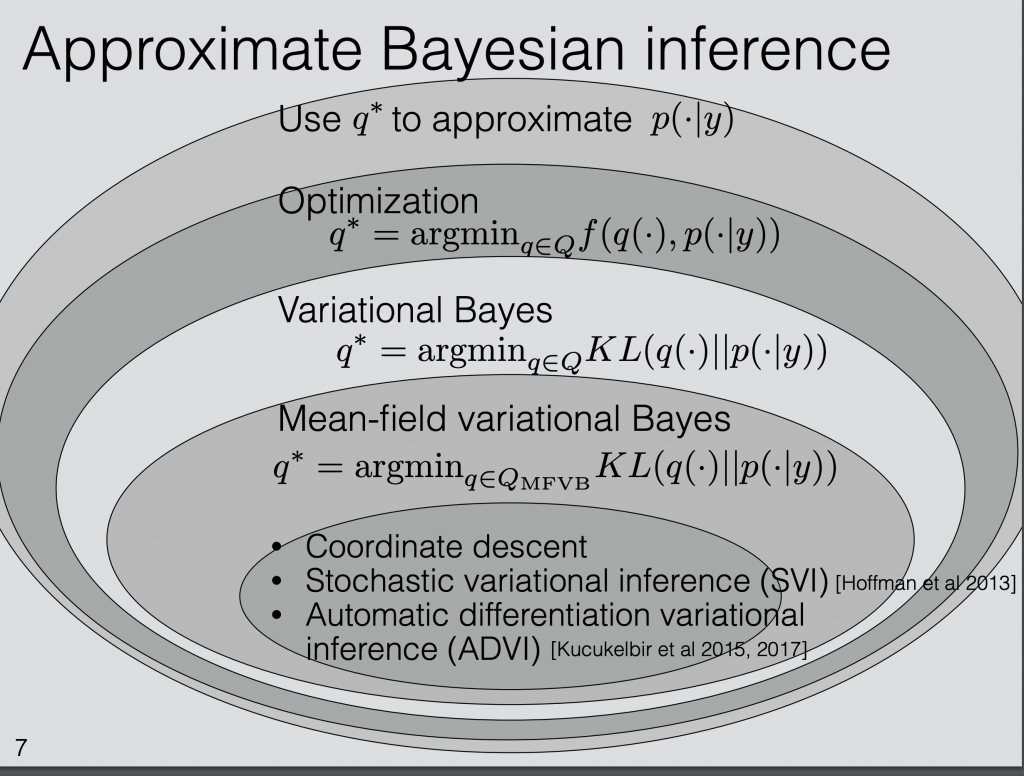
![Rendered by QuickLaTeX.com KL\left(h(x)||g(x)\right)\newline=\int^\infty_{-\infty}h(x)log\frac{h(x)}{g(x)}dx \newline=\mathbb{E}_h[log\;h(x)]-\mathbb{E}_h[log\;g(x)]](https://czxttkl.com/wp-content/ql-cache/quicklatex.com-8501d9a8fd963ea67a6922b3315189d5_l3.png)

![Rendered by QuickLaTeX.com log \; p(x)\newline=log \int_z p(z,x)\newline=log \int_z p(z,x)\frac{q(z)}{q(z)}\newline=log \int_z q(z)\frac{p(z,x)}{q(z)}\newline=log \left(\mathbb{E}_{q(z)}\left[\frac{p(z,x)}{q(z)}\right]\right) \newline \geq \mathbb{E}_{q(z)}\left[log \frac{p(z,x)}{q(z)}\right] \quad\quad \text{by Jensen's inequality} \newline =ELBO(q)](https://czxttkl.com/wp-content/ql-cache/quicklatex.com-24349341ab84453e6b667fde54e71db3_l3.png)
![Rendered by QuickLaTeX.com ELBO(q)\newline=\mathbb{E}_q[log\;p(z,x)] - \mathbb{E}_q[log\;q(z)]\newline=\mathbb{E}_q[log\;p(x|z)] + \mathbb{E}_q[log\;p(z)] - \mathbb{E}_q[log\;q(z)] \quad\quad p(z) \text{ is the prior of } z \newline= \mathbb{E}_q[log\;p(x|z)] - \mathbb{E}_q [log \frac{q(z)}{p(z)}]\newline=\mathbb{E}_q[log\;p(x|z)] - KL\left(q(z) || p(z)\right)](https://czxttkl.com/wp-content/ql-cache/quicklatex.com-aa0eccc6fce4b2b3085999bb67659a1f_l3.png)


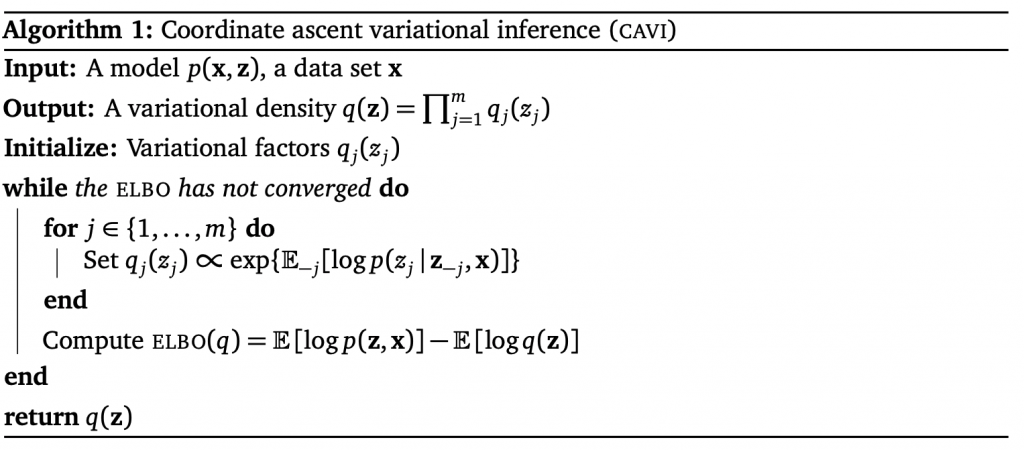
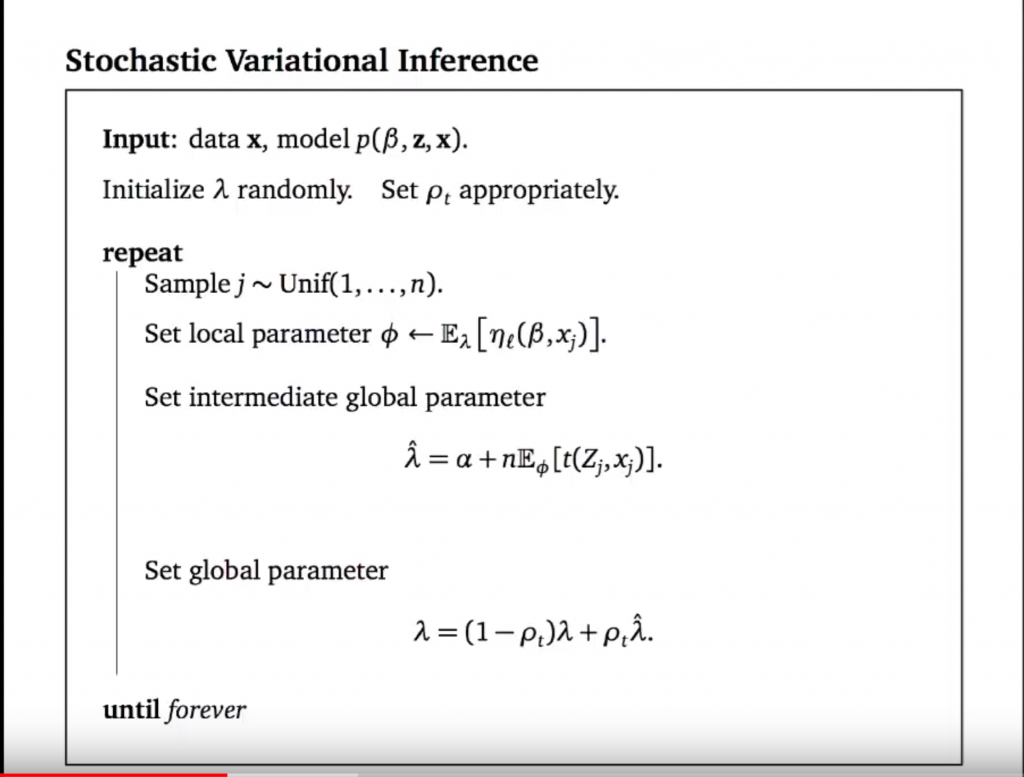

![Rendered by QuickLaTeX.com \mathbb{E}_{p_{\pi_0}(\mathcal{S})}[V^{\pi_1}_{IPS}] \newline (p_{\pi_0}(\mathcal{S}) \text{ is the joint distribution of all samples generated by }\pi_0) \newline = \frac{1}{N}\int p_{\pi_0}(\mathcal{S})\sum\limits_{(s_i, a_i, r_i) \in \mathcal{S}} \frac{r_i \pi_1(a_i|s_i)}{\pi_0(a_i|s_i)} d\mathcal{S} \newline \text{(since each sample is collected independently, we have:)}\newline=\frac{1}{N}\sum\limits_{(s_i, a_i, r_i) \in \mathcal{S}}\int p_{\pi_0}(s_i, a_i)\frac{r(s_i, a_i)\pi_1(a_i|s_i)}{\pi_0(a_i|s_i)}ds_i da_i \newline=\int p_{\pi_0}(s, a)\frac{r(s, a)\pi_1(a|s)}{\pi_0(a|s)}ds da \newline=\int p_\mathcal{D}(s) \pi_0(a|s)\frac{r(s, a)\pi_1(a|s)}{\pi_0(a|s)}dsda \newline=\int p_{\pi_1}(s,a)r(s,a) dsda\newline=V^{\pi_1}](https://czxttkl.com/wp-content/ql-cache/quicklatex.com-bb82f8b47ba652b49135c45939d0b150_l3.png)
![Rendered by QuickLaTeX.com V^{\pi_1}_{DR}=\frac{1}{N}\sum\limits_{(s_i, a_i, r_i) \in \mathcal{S}} \big[\frac{(r_i - \hat{r}(s_i, a_i))\pi_1(a_i|s_i)}{\pi_0(a_i|s_i)} +\int\hat{r}(s_i, a')\pi_1(a'|s_i) da'\big]](https://czxttkl.com/wp-content/ql-cache/quicklatex.com-16c1ae79a43158ca6705a023d35b2d8e_l3.png)
![Rendered by QuickLaTeX.com \mathbb{E}_{p_{\pi_0}(\mathcal{S})}[V^{\pi_1}_{DR}] \newline=\int p_{\pi_0}(s, a) \cdot \big[\frac{(r(s,a) - \hat{r}(s, a))\pi_1(a|s)}{\pi_0(a|s)} +\int \hat{r}(s, a')\pi_1(a'|s) da' \big]ds da \newline=\int p_{\pi_0}(s,a) \cdot\big[\frac{(r(s,a) - \hat{r}(s, a))\pi_1(a|s)}{\pi_0(a|s)} +\int(\hat{r}(s, a') - r(s,a'))\pi_1(a'|s)da' +\int r(s, a')\pi_1(a'|s)da' \big] dsda\newline=\int p_{\pi_1}(s,a) \cdot (-1+1)dsda + \int p_{\pi_1}(s,a) r(s,a) dsda\newline=V^{\pi_1}](https://czxttkl.com/wp-content/ql-cache/quicklatex.com-5b2eddcbd24d5f73844ceadc1403863d_l3.png)


![Rendered by QuickLaTeX.com V^{\pi} = \mathbb{E}_{s_0 \sim \mathcal{D}, a_t \sim \pi(\cdot|s_t), s_{t+1}\sim P(\cdot|a_t, s_t)}[\sum\limits_{t=1}^H\gamma^{t-1}r_t],](https://czxttkl.com/wp-content/ql-cache/quicklatex.com-bfc55bc4eff25229d7795708eb741006_l3.png)
 is the accumulative discounted rewards for the trajectory
is the accumulative discounted rewards for the trajectory 


 and we define the corner case
and we define the corner case 




